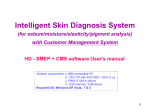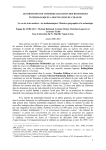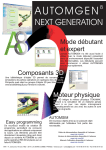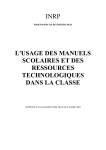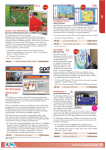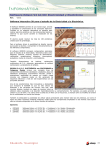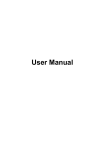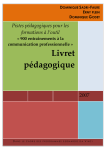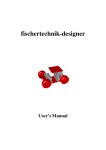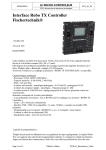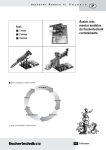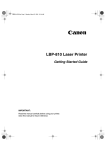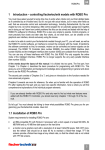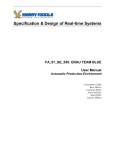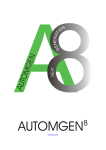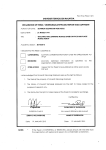Download User`s Manual
Transcript
User Manual The first step to automation Version 1 – (C)opyright 1999-2002 IRAI AUTOMGEN is a registered trademark of IRAI. This trademark may not be used without the prior agreement of IRAI. Introduction The AUTOMGEN Starter Kit allows you to discover the world of automation. As you will have already noticed automation is everywhere in our daily life. This fascinating technology allows you to make your most ambitious projects come to life in an entertaining way. Let's get started straight away..... Installing the program The AUTOMGEN Starter Kit program requires a PC compatible computer with the following specification : WINDOWS 95, 98, ME, NT4, 2000 or XP operating system, at least 16MB of memory, at least 30MB of free space available on the hard drive, a video card with a resolution of at least 800 x 600 pixels in 65535 colour mode, - a CD-ROM drive, - a mouse. - Start up your computer and place the AUTOMGEN Starter Kit CD-ROM in the CD-ROM drive. The installation program is normally launched automatically. If this does not occur, click on the Windows "Start" button, select "Run", then use the "Browse" button to select the file "Setup.exe" from the root directory of the CD-ROM. Answer the questions displayed by the installation program.... AUTOMGEN Starter Kit - Version 1.03 1 The demonstration copy The AUTOMGEN Starter Kit demonstration copy is supplied for evaluation purposes only. This version of the program does not allow the applications developed to be saved. It can be upgraded to the full version of the product by inputting a registration number which will supplied when your order is processed. The technical and commercial teams at IRAI would like to thank you for the interest which you have shown in their products. Contacting IRAI For all technical questions and comments please contact us by: Telephone : (33) 4 66 54 91 30 Fax : (33) 4 66 54 91 33 E-mail : [email protected] You can also obtain further product information from our Internet site : http://www.irai.com AUTOMGEN Starter Kit - Version 1.03 2 Getting started with the AUTOMGEN Starter Kit From the Windows "Start" menu choose the "Programs" option, then "AUTOMGEN Starter Kit". From the list of options1 choose " Simulation ". This mode allows the program to be used without a model or interface. Next click on the "Start" button … 1 Depending on the version of AUTOMGEN STARTER KIT the list of options may be limited to one type of operational model. AUTOMGEN Starter Kit - Version 1.03 3 Click on the "Open" button on the tool bar at the top of the screen. Open the file called "Example" in the sub-directory "example\general" of the directory where the AUTOMGEN Starter Kit has been installed (the default installation directory is C:\Program Files\IRAI\Ask). Ckick here AUTOMGEN Starter Kit - Version 1.03 4 Click on the "Run" button. Click here AUTOMGEN Starter Kit - Version 1.03 5 Click in this area … Comment : clicking on the switches with the left button of the mouse changes their setting (bistable), the right button returns them to their default setting (monostable). This ends our quick introduction to the AUTOMGEN Starter Kit program. We will leave you to explore the other examples. The rest of the manual shows you how to use the ASK development environment and simplified graphical automation language to construct the steps in your automation programs... AUTOMGEN Starter Kit - Version 1.03 6 The ASK environment Choice of option As we have discovered in the previous chapter that an option must be chosen when opening the program. This choice determines the elements available to create a program and the way in which it will be run (control or simulation of a particular interface, simulation, etc ...). Ticking the box "Please do not show this dialog box on start up" allows the option displayed by AUTOMGEN STATER KIT on start up to be set. When the program is restarted it will display the option which was last used without offering a choice to the user. To display the selection dialog box again press the [SHIFT] key on the keyboard while AUTOMGEN STARTER KIT is starting up. Choosing the display mode The radio buttons "professional environment" and "standard environment" allow the user to choose between two styles of environment according to their preference. Registering the program A licence number will be supplied when you decide to purchase the AUTOMGEN STARTER KIT. This licence number is your unique personal number and must not be communicated to anyone else. The "LICENCE" button allows you to input the licence number and convert the demonstration copy into a full version of the program. AUTOMGEN Starter Kit - Version 1.03 7 Creating programs Designing a program The creation of programs can be carried out entirely by using the mouse. In principal a program is created by dragging elements (blocks) from the tool bar on the right or left of the screen and placing them on the work sheet. Work sheet Tool bar Modifying the settings for a block Certain blocks may be set to behave in several possible ways, these are referred to as configurable blocks, for example a timing block may cause a long or short delay. AUTOMGEN Starter Kit - Version 1.03 8 The configurable blocks can be recognised by a data box. The box contents are green characters on a black background. To modify the setting of the block place the mouse cursor over the data box. The settings will then be visible. If a data box contains a numerical value buttons marked "+" and "-" will appear below it. By clicking on the buttons the value can be changed. The value can also be modified directly by clicking on the field and typing in the new value using the keyboard. Moving the mouse cursor outside the field saves the new value. If the data box does not contain a numerical value then a menu will appear. In this case the setting is modified by choosing an item from the menu with the mouse. Moving a block To move the position of a block on the work sheet, place the cursor over the block, hold down the left mouse button and move the cursor to the new position. Releasing the mouse button places the block in the new position. Deleting a block Click on a block with the right mouse button and choose "Delete" from the menu displayed. Selecting one or more Click on a block to select it or deselect it (this acts as a selection switch). Black crosses appear at the four corners of the selected block. If the [SHIFT] key is held down more than one block can be selected by clicking on each block in turn. Another method for selecting a group of blocks is to click on the empty area of the work sheet and keep the left button of the AUTOMGEN Starter Kit - Version 1.03 9 mouse depressed. Moving the cursor with the button held down will draw a line. Releasing the mouse button will select all the blocks which are fully or partially in the area defined by the line. The blocks marked in this way may be moved or deleted by using the same method as for a single block. AUTOMGEN Starter Kit - Version 1.03 10 The ASK simplified graphical automation language This language draws its inspiration from GRAFCET which is currently the reference standard in the world of automation. The ASK language is made up of two groups of elements : actions and tests. The language is based on the concept of "state". For a state there is a corresponding action. The change from one state to another is conditional on a test. Consider the example of a train described in everyday language... The train is at a standstill Until the driver moves the lever to advance the train. The train advances Until the driver moves the lever to stop the train. And so on … If these lines appear logical to you then you will have no problems using the ASK language... AUTOMGEN Starter Kit - Version 1.03 11 The essential rules in the ASK language are : - an action can only be followed by a test or nothing, - a test can only be followed by an action or nothing. The graphical elements in the ASK language ♦ Actions are displayed in blue. ♦ Tests are displayed in green. ♦ Links are represented by arrows. Here is an example of a program : An action A test An action A test A link AUTOMGEN Starter Kit - Version 1.03 12 Actions • A line of action starts with either an block (if the action must take place at the start of the program) or an block (otherwise). • To the right of these blocks there will be : - Nothing if nothing has to happen, block if the action must take place while the - a state is active and stop when it is exited, - an if the action must be activated in this state (it will continue even after exiting the state), block if the action must be deactivated (this - a stops an action started by the "Activate..." block. • To the right of these blocks there is a block defining the action to be performed : AUTOMGEN Starter Kit - Version 1.03 13 block to activate a general type of output - a variable. Special blocks are also available depending on the option. - a block to introduce a time factor (see later). or - a variable (see later). block to process a numeric If several actions are to be performed further blocks can be placed to the right (the last two steps described above). For example : Tests • A test line starts with the block. • To the right of this block there is : - nothing if the test is always true (in this case the program always passes on to the next action), AUTOMGEN Starter Kit - Version 1.03 14 - one or more blocks making up the condition : - the block to perform a general test on an input variable, special blocks are also available depending on the option. - the later). block tests for the end of a time delay (see - the and variable (see later). , - the and blocks test a numeric , , , blocks allow equations to be defined. For example : AUTOMGEN Starter Kit - Version 1.03 15 tests input 0, input 1 and not input 2. block tests the presence (automation The specialists talk about a "firing condition" or "triggering condition") of an item of data. Links The links which simply allow an action to be linked to a test (which is useful for looping a program such as our previous example). Parallel processes The ASK language may be used to define several tasks which must be performed at the same time. To do this it is sufficient to draw several paths on the program work sheet. Example : Choices and The follow two different paths. blocks allow the program to AUTOMGEN Starter Kit - Version 1.03 16 block must be written below an action, the two The branches created must lead to two tests. block allows two branches to be combined into a The single one. The two branches must come from two tests. The branch below must lead to an action. Example : The other language elements Temporisation Temporisations are the language elements which allow time delays to be defined. A temporisation is identified by a number from 0 to 200 and possesses a duration between 0 and 65535 expressed in tenths of a second. AUTOMGEN Starter Kit - Version 1.03 17 A temporisation is started by an action. The end of the temporisation is tested by a test. It is only possible to use each temporisation number once in each program. Below is an example of a program using temporisation. When the program is run, temporisation 0 is started with a duration of 2 seconds, when the temporisation ends the program continues. Conditional Actions block allows a condition to be added to an The action. One or more condition blocks must be placed to the right of this block. The block easily allows a response to a warning. It must be placed to the right of a AUTOMGEN Starter Kit - Version 1.03 block. 18 Example : Working with numeric variables The ASK language allows the use of numeric variables called "words". The numeric variables are identified by the letter "W" followed by a number from 200 to 4999 (the words 0 to 199 are reserved). The words are 16 bit encoded signed numeric variables. Two action blocks allow a constant to be placed in a word or a calculation to be performed between two words and the result placed in a third word. Two test blocks allow the comparison of a numeric variable with a constant or another word. AUTOMGEN Starter Kit - Version 1.03 19 Example : count four pushes on a push button connected to input 0 before activating output 0. AUTOMGEN Starter Kit - Version 1.03 20 Creating our first program Our objectives are as follows : - We are going to use the "Simulation" option, - Pushing the push button connected to input 3 will light up the warning light connected to output 4 for 5 seconds, - If the button is pressed again, the warning light lights up again for 5 seconds and so on... AUTOMGEN Starter Kit - Version 1.03 21 AUTOMGEN Starter Kit - Version 1.03 22 AUTOMGEN Starter Kit - Version 1.03 23 AUTOMGEN Starter Kit - Version 1.03 24 AUTOMGEN Starter Kit - Version 1.03 25 AUTOMGEN Starter Kit - Version 1.03 26 AUTOMGEN Starter Kit - Version 1.03 27 Comment : by clicking with the right mouse button on switch 3 it behaves as a monostable push button. AUTOMGEN Starter Kit - Version 1.03 28 Appendix Options, input and output interfaces AUTOMGEN Starter Kit - Version 1.03 The POLYFUNCTION operating section from POLYDIS. ® The POLYFONCTION name is a registered trademark. © POLYDIS. Used with the kind permission of POLYDIS To use this option you must connect an RPX I/O input/output module configured as slave number 1. The cabling to the RPX I/O interface of the sensors and activators must conform to that described in the technical documentation supplied by POLYDIS. AUTOMGEN Starter Kit - Version 1.03 ® The FISCHERTECHNIK model elevator ® The name FISCHERTECHNIK is a registered trademark. © FISCHERTECHNIK. Used with the kind permission of FINAL. To use this option you must connect the FISCHERTECHNIK® interface to the parallel port on the PC. The cabling of the sensors and activators is as follows: OUTPUT : Raise elevator Lower elevator Green warning light Orange warning light Red warning light O0 O1 O2 O3 O4 INPUTS Call the elevator to the ground floor Call the elevator to level 1 Call the elevator to level 2 Elevator present at level 0 Elevator present at level 1 Elevator present at level 2 I0 I1 I2 I3 I4 I5 AUTOMGEN Starter Kit - Version 1.03 ® The LEGO model Cream Machine” “Ice ® The names LEGO, LEGO Dacta are registered trademarks. © Groupe LEGO. Used with the kind permission of LEGO Dacta France To use this option you must use the following cabling : Rotary sensor Blue ice cream dispenser Rotary sensor yellow ice cream dispenser Push button Blue light Yellow light Green light Buzzer Yellow ice cream distributor motor Blue icecream distributor motor Optical sensor portion detection AUTOMGEN Starter Kit - Version 1.03 ® The driver for the LEGO interface ® The names LEGO, LEGO Dacta are registered trademarks. © Groupe LEGO. With the kind permission of LEGO Dacta France Settings The driver automatically configures itself. The interface can be connected to COM 1 or COM 2, it is detected automatically on running the automation application. Connection The connection between the computer and the LEGO® interface must be made using the serial connecting cable supplied by LEGO®. Communication with inputs / outputs The following variables communicate with the interface : Inputs I0 to I7 : the 8 Boolean states of the interface inputs. Outputs O0 to O15 : the 16 Boolean interface outputs : O0 = position 1 of output A, O1 = position 2 of output A, O2 = position 1 of output B, O3 = position 2 of output B, O4 = position 1 of output C, O5 = position 2 of output C, O6 = position 1 of output D, O7 = position 2 of output D, O8 = position 1 of output E, O9 = position 2 of output E, O10 = position 1 of output F, AUTOMGEN Starter Kit - Version 1.03 O11 = position 2 of output F, O12 = position 1 of output G, O13 = position 2 of output G, O14 = position 1 of output H, O15 = position 2 of output H. Comment : if positions 1 and 2 of an output are driven at the same time, then the output is not driven in either position. Words W200 to W207 : the 8 analogue inputs for the temperature sensor and optical sensor. Words W208 to W215 : the 8 digital inputs for the angular position sensor. Input I8 gives the operational state of the interface : I8=1 if the interface is connected and the operation is correct, I8=0 if the interface is disconnected or the STOP button is pushed down. AUTOMGEN Starter Kit - Version 1.03 ® The driver for the RPX I/O interface ® The name RPX I/O is a registered trademark. © CROUZET AUTOMATISME Settings The driver is automatically configured. The interface can be connected to COM1 or COM2, it is detected automatically on running the application. Only one module can be connected. The module must be configured to address 1 : switches i0 to i4 to 0, switch i5 to 1. The parity must be set to "no parity" : switch i6 to 0. The speed is automatically detected and may be adjusted to one of the possible values, 38400 baud (i8 to 1 and i9 to 1), 19200 baud (i8 to 0 and i9 to 1), 9600 baud (i8 to 1 and i9 to 0) or 4800 baud (i8 to 1 and i9 to 1). The RPX I/O interface watchdog is activated automatically. The outputs default to state 0 if there is a break in communication. Connection The connection between the RPX I/O interface and the computer must be made using an RS232/RS485 converter (see CROUZET documentation). Communication with inputs/outputs Only the Boolean inputs and outputs are usable. 16 I inputs and 16 O outputs are reserved for each RPX I/O interface module The following variables communicate with the interface : I0 I1 I2 I000 I001 I002 O0 O000 O1 O001 O2 O002 AUTOMGEN Starter Kit - Version 1.03 Etc … I16 I100 I17 I101 Etc … Etc … O16 O100 O17 O101 Etc… Input I128 gives the operational state of the interface. I128=1 if the interface is connected. I128=0 if the interface is disconnected. AUTOMGEN Starter Kit - Version 1.03 ® The driver for the PILOTIX interface ® The name PILOTIX is a registered trademark © LOGEDIC Groupe CHRYSIS Used with the kind permission of LOGEDIC Groupe CHRYSIS. Settings The driver is configured to control the PILOTEX® interface through the LPT1 parallel port. Connection The connection between the PILOTIX® interface and the computer must be made using a parallel connecting cable. Communication with inputs/outputs The following variables communicate with the interface : Inputs I0 to I7 : the 8 Boolean states of the interface inputs. Outputs O0 to O8 : the 8 Boolean states of the interface outputs. AUTOMGEN Starter Kit - Version 1.03 The driver for the ® FISCHERTECHNIK interface ® The name FISCHERTECHNIK is a registered trademark. © FISCHER With the kind permission of FINAL. Settings The driver is configured automatically. The interface can be connected to LPT1, LPT2, LPT3 or LPT4. It is automatically detected on running the automation application. Two modules can be connected. Connection The connection between the FISCHERTECHNIK interface and the computer must be made using the parallel connection cable supplied by FISCHERTECHNIK. Communication with inputs/outputs The following variables communicate with the interface : Inputs I0 to I15 : the 16 Boolean states of the interface inputs. Outputs O0 to O15 : the 16 Boolean interface outputs : O0 = position 1 of output W1, O1 = position 2 of output W1, O2 = position 1 of output W2, O3 = position 2 of output W2, O4 = position 1 of output W3, O5 = position 2 of output W3, O6 = position 1 of output W4, O7 = position 2 of output W4, O8 = position 1 of output W5, AUTOMGEN Starter Kit - Version 1.03 O9 = position 2 of output W5, O10 = position 1 of output W6, O11 = position 2 of output W6, O12 = position 1 of output W7, O13 = position 2 of output W7, O14 = position 1 of output W8, O15 = position 2 of output W8. Words W200 to W201 : the 2 analogue inputs. Input I16 gives the operational state of the interface : I16=1 if the interface is connected and operating correctly, I16=0 if the interface is disconnected. AUTOMGEN Starter Kit - Version 1.03 The driver for the ATECH interface Settings The driver is configured automatically. Connection The connection between the ATECH interface and the computer must be made with a parallel cable. Communication with inputs / outputs The following variables communicate with the interface: Inputs I0 to I11 : the 12 Boolean interface inputs. Outputs O0 to O7 : the 8 Boolean interface outputs : AUTOMGEN Starter Kit - Version 1.03 ® The driver for the LEGO 9771 interface ® The names LEGO, LEGO Dacta are registered trademarks. © Groupe LEGO. Used with the kind permission of LEGO Dacta France Settings The driver is configured automatically. Connection The connection between the LEGO® 9771 interface and the computer must be made using the cable supplied by LEGO®. Communication with inputs / outputs The following variables communicate with the interface : Inputs I0 to I1 : the 2 Boolean states of the interface inputs. Outputs O0 to O5 : the 6 Boolean interface outputs : O0 = output 0 and position 1 of output A, O1 = output 1 and position 2 of output A, O2 = output 2 and position 1 of output B, O3 = output 3 and position 2 of output B, O4 = output 4 and position 1 of output C, O5 = output 5 and position 2 of output C, AUTOMGEN Starter Kit - Version 1.03












































